建立堆栈和队列的库函数
- 格式:docx
- 大小:126.13 KB
- 文档页数:9
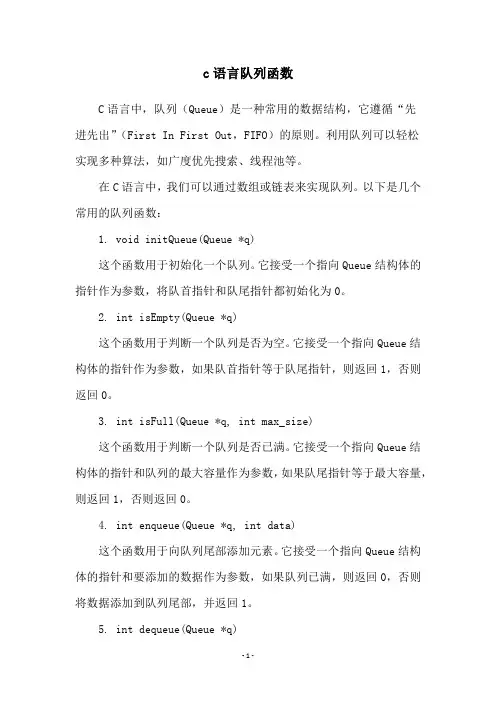
c语言队列函数
C语言中,队列(Queue)是一种常用的数据结构,它遵循“先
进先出”(First In First Out,FIFO)的原则。
利用队列可以轻松
实现多种算法,如广度优先搜索、线程池等。
在C语言中,我们可以通过数组或链表来实现队列。
以下是几个常用的队列函数:
1. void initQueue(Queue *q)
这个函数用于初始化一个队列。
它接受一个指向Queue结构体的指针作为参数,将队首指针和队尾指针都初始化为0。
2. int isEmpty(Queue *q)
这个函数用于判断一个队列是否为空。
它接受一个指向Queue结构体的指针作为参数,如果队首指针等于队尾指针,则返回1,否则返回0。
3. int isFull(Queue *q, int max_size)
这个函数用于判断一个队列是否已满。
它接受一个指向Queue结构体的指针和队列的最大容量作为参数,如果队尾指针等于最大容量,则返回1,否则返回0。
4. int enqueue(Queue *q, int data)
这个函数用于向队列尾部添加元素。
它接受一个指向Queue结构体的指针和要添加的数据作为参数,如果队列已满,则返回0,否则将数据添加到队列尾部,并返回1。
5. int dequeue(Queue *q)
这个函数用于从队列头部删除元素。
它接受一个指向Queue结构体的指针作为参数,如果队列为空,则返回0,否则将队首元素删除,并返回该元素的值。
以上是几个常用的C语言队列函数,它们可以帮助我们轻松地实现队列数据结构。
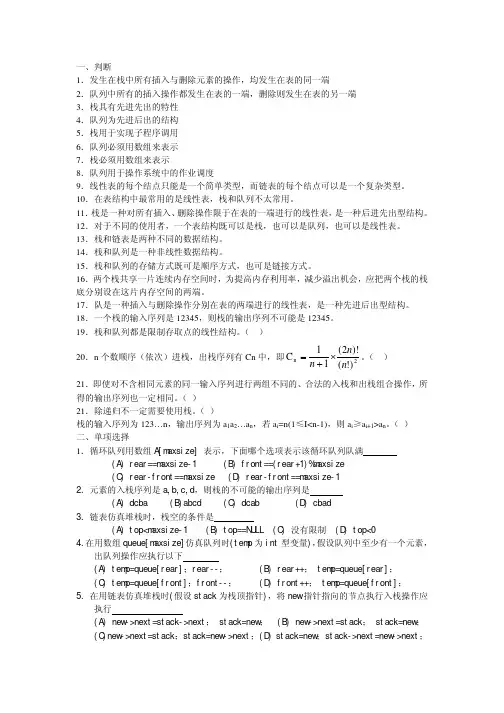

c语言队列数据结构队列是一种常见的数据结构,它遵循先进先出(FIFO)的原则。
在C语言中,我们可以使用数组或链表来实现队列数据结构。
本文将介绍C语言中队列的实现方法及其应用。
一、数组实现队列数组是一种简单且常用的数据结构,可以用来实现队列。
在C语言中,我们可以使用数组来创建一个固定大小的队列。
下面是一个使用数组实现队列的示例代码:```c#include <stdio.h>#define MAX_SIZE 100int queue[MAX_SIZE];int front = -1;int rear = -1;void enqueue(int data) {if (rear == MAX_SIZE - 1) {printf("队列已满,无法插入元素。
\n");return;}if (front == -1) {front = 0;}rear++;queue[rear] = data;}void dequeue() {if (front == -1 || front > rear) {printf("队列为空,无法删除元素。
\n"); return;}front++;}int getFront() {if (front == -1 || front > rear) {printf("队列为空。
\n");return -1;}return queue[front];}int isEmpty() {if (front == -1 || front > rear) {return 1;}return 0;}int main() {enqueue(1);enqueue(2);enqueue(3);printf("队列的第一个元素:%d\n", getFront());dequeue();printf("队列的第一个元素:%d\n", getFront());return 0;}```在上述代码中,我们使用了一个数组`queue`来存储队列的元素。

中国科学院大学硕士研究生入学考试《程序设计》考试大纲本《程序设计》考试大纲适用于中国科学院大学计算机科学与技术类的硕士研究生入学考试。
程序设计是计算机科学与技术及相关学科的重要基础,主要内容包括数据结构和C 程序设计两大部分。
要求考生对计算机科学与技术及相关学科的基本概念有较深入、系统的理解,掌握各种数据结构的定义和实现算法,对C语言的基本知识有较深入的了解,掌握程序设计的基本方法,并具有综合运用所学知识分析问题和解决问题的能力。
一、考试内容数据结构1、绪论(1)数据结构的基本概念,数据的逻辑结构、存储结构。
(2)算法的定义、算法的基本特性以及算法分析的基本概念。
2、线性表(1)线性关系、线性表的定义,线性表的基本操作。
(2)线性表的顺序存储结构与链式存储结构(包括单链表、循环链表和双向链表)的构造原理。
在以上两种存储结构上对线性表实施的最主要的操作(包括三种链表的建立、插入和删除、检索等)的算法设计。
3、堆栈与队列(1)堆栈与队列的基本概念、基本操作。
(2)堆栈与队列的顺序存储结构与链式存储结构的构造原理。
(3)在不同存储结构的基础上对堆栈与队列实施插入与删除等基本操作对应的算法设计。
4、串(1)串的基本概念、串的基本操作和存储结构。
(2)串的模式匹配算法和改进的KMP算法5、数组和广义表(1)数组的概念、多维数组的实现(2)对称矩阵和稀疏矩阵的压缩存储(3)广义表的基本概念6、树与二叉树(1)树的定义和性质(2)二叉树的概念、性质和实现(3)遍历二叉树和线索二叉树(4)树和森林(5)赫夫曼树及其应用(6)树的计数7、图(1)图的定义,基本概念,图的分类,常用名词术语。
(2)图的邻接矩阵存储方法、邻接表存储方法的构造原理。
(3)图的遍历操作。
(4)最小生成树,最短路径,AOV网与拓扑排序。
8、文件及查找(1)数据文件的基本概念和基本术语,数据文件的基本操作。
(2)顺序文件、索引文件、散列(Hash)文件。
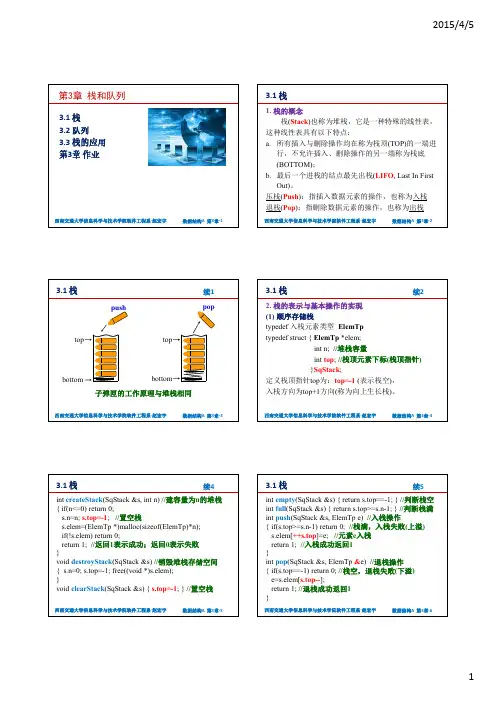
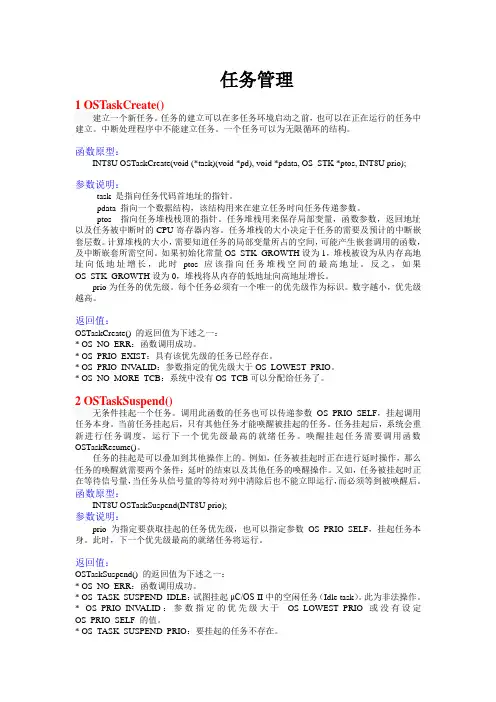
任务管理1 OSTaskCreate()建立一个新任务。
任务的建立可以在多任务环境启动之前,也可以在正在运行的任务中建立。
中断处理程序中不能建立任务。
一个任务可以为无限循环的结构。
函数原型:INT8U OSTaskCreate(void (*task)(void *pd), void *pdata, OS_STK *ptos, INT8U prio);参数说明:task 是指向任务代码首地址的指针。
pdata 指向一个数据结构,该结构用来在建立任务时向任务传递参数。
ptos 指向任务堆栈栈顶的指针。
任务堆栈用来保存局部变量,函数参数,返回地址以及任务被中断时的CPU寄存器内容。
任务堆栈的大小决定于任务的需要及预计的中断嵌套层数。
计算堆栈的大小,需要知道任务的局部变量所占的空间,可能产生嵌套调用的函数,及中断嵌套所需空间。
如果初始化常量OS_STK_GROWTH设为1,堆栈被设为从内存高地址向低地址增长,此时ptos应该指向任务堆栈空间的最高地址。
反之,如果OS_STK_GROWTH设为0,堆栈将从内存的低地址向高地址增长。
prio为任务的优先级。
每个任务必须有一个唯一的优先级作为标识。
数字越小,优先级越高。
返回值:OSTaskCreate() 的返回值为下述之一:* OS_NO_ERR:函数调用成功。
* OS_PRIO_EXIST:具有该优先级的任务已经存在。
* OS_PRIO_INV ALID:参数指定的优先级大于OS_LOWEST_PRIO。
* OS_NO_MORE_TCB:系统中没有OS_TCB可以分配给任务了。
2 OSTaskSuspend()无条件挂起一个任务。
调用此函数的任务也可以传递参数OS_PRIO_SELF,挂起调用任务本身。
当前任务挂起后,只有其他任务才能唤醒被挂起的任务。
任务挂起后,系统会重新进行任务调度,运行下一个优先级最高的就绪任务。
唤醒挂起任务需要调用函数OSTaskResume()。
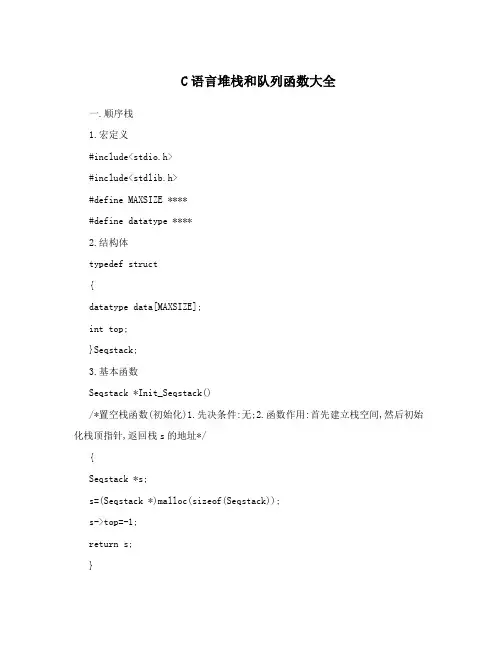
C语言堆栈和队列函数大全一.顺序栈1.宏定义#include<stdio.h>#include<stdlib.h>#define MAXSIZE ****#define datatype ****2.结构体typedef struct{datatype data[MAXSIZE];int top;}Seqstack;3.基本函数Seqstack *Init_Seqstack()/*置空栈函数(初始化)1.先决条件:无;2.函数作用:首先建立栈空间,然后初始化栈顶指针,返回栈s的地址*/{Seqstack *s;s=(Seqstack *)malloc(sizeof(Seqstack));s->top=-1;return s;}int Empty_Seqstack(Seqstack *s) /*判栈空函数1.先决条件:初始化顺序栈;2.函数作用:判断栈是否为空,空返回1,不空返回0*/ {if(s->top==-1) return 1;else return 0;}int Push_Seqstack(Seqstack *s,datatype x) /*入栈函数1.先决条件:初始化顺序栈2.函数作用:将数据x入栈,栈满则不能,成功返回1,因栈满失败返回0*/ {if(s->top==MAXSIZE-1)return 0;s->top=s->top+1;s->data[s->top]=x;return 1;}int Pop_Seqstack(Seqstack *s,datatype *x) acidity, mL.; M--calibration of the molar concentration of sodium hydroxide standard solution, moI/L; V--amount of the volume of sodium hydroxide standard solution, Ml; M--the weight of the sample, g. Such as poor meets the requirements, take the arithmetic mean of the second determination as a result. Results one decimal. 6, allowing differential analyst simultaneously or in quick succession for the second determination, the absolute value of the difference of the results. This value should be no more than 1.0. 1, definitions and principles for determination of ash in starches, starch and ash: starch samples of ash the residue obtainedafter weight. Original sample residue weight of sample weight or weight expressed as a percentage of the dry weight of the sample. Samples ofash at 900 ? high temperature until ashing sample ... The Crucible: determination of Platinum or other conditions of the affected material, capacity of 50mL. Dryer: has effectively adequate drying agent and-perforated metal plate or porcelain. Ashing furnaces: device for controlling and regulating temperature, offers 900 incineration temperature of 25 c. Analytical balance. Electric hot plate or Bunsen. 3, crucible of analysis steps preparation: Crucible must first wash with boiling dilute hydrochloric acid, then wash with a lot of water and then rinse with distilled water. Wash the Crucible within ashing furnace, heated at 900 to 25 ? 30min, and in the desiccator to cool to room temperature and then weighing,/*出栈函数1.先决条件:初始化顺序栈2.函数作用:从栈中出一个数据,并将其存放到x中,成功返回1,因栈空失败返回0*/{if(s->top==-1)return 0;*x=s->data[s->top];s->top--;return 1;}int Top_Seqstack(Seqstack *s,datatype *x)/*取栈顶元素函数1.先决条件:初始化顺序栈2.函数作用:取栈顶元素,并把其存放到x中,成功返回1,因栈空失败返回0*/{if(s->top==-1)return 0;*x=s->data[s->top];return 1;}int Printf_Seqstack(Seqstack *s) /*遍历顺序栈函数1.先决条件:初始化顺序栈2.函数作用:遍历顺序栈,成功返回1*/ {int i,j=0;for(i=s->top;i>=0;i--){printf("%d ",s->data[i]);/*因datatype不同而不同*/j++;if(j%10==0)printf("\n");}printf("\n");return 1;}int Conversation_Seqstack(int N,int r) /*数制转换函数(顺序栈)1.先决条件:具有置空栈,入栈,出栈函数2.函数作用:将N转换为r进制的数*/{Seqstack *s;datatype x;printf("%d转为%d进制的数为:",N,r);/*以后可以删除去*/s=Init_Seqstack();do{Push_Seqstack(s,N%r);N=N/r;acidity, mL.; M--calibration of the molar concentration of sodium hydroxide standard solution, moI/L; V--amount of the volume of sodium hydroxide standard solution, Ml; M--the weight of the sample, g. Such as poor meets the requirements, take the arithmetic mean of the second determination as a result. Results one decimal. 6, allowing differential analyst simultaneously or in quick succession for the second determination, the absolute value of the difference of the results. This value should be no more than 1.0. 1, definitions and principles for determination of ash in starches, starch and ash: starch samples of ash the residue obtained after weight. Original sample residue weight of sample weight or weight expressed as a percentage of the dry weight of the sample. Samples of ash at 900 ? high temperature until ashing sample ... The Crucible: determination of Platinum or other conditions of the affected material, capacity of 50mL. Dryer: has effectivelyadequate drying agent and-perforated metal plate or porcelain. Ashing furnaces: device for controlling and regulating temperature, offers 900 incineration temperature of 25 c. Analytical balance. Electric hot plate or Bunsen. 3, crucible of analysis steps preparation: Crucible mustfirst wash with boiling dilute hydrochloric acid, then wash with a lot of water and then rinse with distilled water. Wash the Crucible within ashing furnace, heated at 900 to 25 ? 30min, and in the desiccator to cool to room temperature and then weighing,}while(N);while(Pop_Seqstack(s,&x)){if(x>=10)/*为了能转为十进制以上的*/printf("%c",x+55);elseprintf("%d",x);}free(s);/*释放顺序栈*/printf("\n");return 1;}4.主函数int main(){Seqstack *s;int choice;datatype x;do{printf("************************************************************ ****\n");printf("1.置空栈 2.判栈空 3.入栈 4.出栈 5.取栈顶元素 6.遍历 7.退出\n");printf("************************************************************ ****\n");printf("请输入选择(1~7):");scanf("%d",&choice);getchar();switch(choice){case 1:s=Init_Seqstack();if(s)printf("置空栈成功!\n");break;case 2:if(Empty_Seqstack(s))printf("此为空栈.\n");elseprintf("此不为空栈.\n");;break;case 3:printf("请输入一个整数:");scanf("%d",&x);if(Push_Seqstack(s,x))printf("入栈成功.\n");elseprintf("栈已满,无法入栈.\n");;break;case 4:if(Pop_Seqstack(s,&x)) acidity, mL.; M--calibration of the molar concentration of sodium hydroxide standard solution, moI/L; V--amount of the volume of sodium hydroxide standard solution, Ml; M--the weight of the sample, g. Such as poor meets the requirements, take the arithmetic mean of the second determination as a result. Results one decimal. 6, allowing differential analyst simultaneously or in quick succession for the second determination, the absolute value of the difference of the results. This value should be no more than 1.0. 1, definitions and principles for determination of ash in starches, starch and ash: starch samples of ash the residue obtained after weight. Original sample residue weight of sample weight or weight expressed as a percentage of the dry weight of the sample. Samples of ash at 900 ? high temperature until ashing sample ... The Crucible: determination of Platinum or other conditions of the affected material, capacity of 50mL. Dryer: has effectively adequate drying agent and-perforated metal plate or porcelain. Ashing furnaces: device for controlling and regulating temperature, offers 900 incineration temperature of 25 c. Analytical balance. Electric hot plate or Bunsen. 3, crucible of analysis steps preparation: Crucible must first wash with boiling dilute hydrochloric acid, then wash with a lot of water and then rinse with distilled water.Wash the Crucible within ashing furnace, heated at 900 to 25 ? 30min, and in the desiccator to cool to room temperature and then weighing, printf("出栈成功,出栈元素为:%d\n",x);elseprintf("出栈失败,因栈为空.\n");break;case 5:if(Top_Seqstack(s,&x))printf("取栈顶元素成功,栈顶元素为:%d\n",x);elseprintf("取栈顶元素失败,因栈为空.\n");break;case 6:Printf_Seqstack(s);break;case 7:printf("谢谢使用!\n");break;default :printf("输入错误,请重新输入!\n");break;}}while(choice!=7);return 0;}二.链栈1.宏定义#include<stdio.h>#include<stdlib.h>#define datatype ****2.结构体typedef struct snode{datatype data;struct snode *next;}Stacknode,*Linkstack;3.基本函数Linkstack Init_Linkstack()/*初始化栈函数1.先决条件:无2.函数作用:初始化链栈,返回top地址*/ { Linkstack top;top=(Linkstack)malloc(sizeof(Stacknode));top->next=NULL;return top;}int Empty_Linkstack(Linkstack top) /*判栈空函数1.先决条件:初始化链栈2.函数作用:判断栈是否为空,空返回1,不空返回0*/{if(top->next==NULL)acidity, mL.; M--calibration of the molar concentration of sodium hydroxide standard solution, moI/L; V--amount of the volume of sodium hydroxide standard solution, Ml; M--the weight of the sample, g. Such as poor meets the requirements, take the arithmetic mean of the second determination as a result. Results one decimal. 6, allowing differential analyst simultaneously or in quick succession for the second determination, the absolute value of the difference of the results. This value should be no more than 1.0. 1, definitions and principles fordetermination of ash in starches, starch and ash: starch samples of ash the residue obtained after weight. Original sample residue weight of sample weight or weight expressed as a percentage of the dry weight of the sample. Samples of ash at 900 ? high temperature until ashing sample ... The Crucible: determination of Platinum or other conditions of the affected material, capacity of 50mL. Dryer: has effectively adequate drying agent and-perforated metal plate or porcelain. Ashing furnaces: device for controlling and regulating temperature, offers 900 incineration temperature of 25 c. Analytical balance. Electric hot plate or Bunsen. 3, crucible of analysis steps preparation: Crucible mustfirst wash with boiling dilute hydrochloric acid, then wash with a lot of water and then rinse with distilled water. Wash the Crucible within ashing furnace, heated at 900 to 25 ? 30min, and in the desiccator to cool to room temperature and then weighing,return 1;else return 0;}int Push_Linkstack(Linkstack top,datatype x) /*入栈函数1.先决条件:初始化链栈2.函数作用:将数据x入栈,成功返回1,失败返回0*/ { Stacknode *p;p=(Stacknode *)malloc(sizeof(Stacknode));p->data=x;p->next=top->next;top->next=p;return 1;}int Pop_Linkstack(Linkstack top,datatype *x) /*出栈函数1.先决条件:初始化链栈2.函数作用:若栈空退出,若没空则将数据出栈,并将其存放到x中,成功返回1,因栈空失败返回0*/{if(top->next==NULL)return 0;Stacknode *p=top->next;*x=p->data;top->next=p->next;free(p);return 1;}int Top_Linkstack(Linkstack top,datatype *x) /*取栈顶元素函数1.先决条件:初始化链栈2.函数作用:取栈顶元素并放到x中,成功返回1,因栈空失败返回0*/{if(top->next==NULL)return 0;*x=top->next->data;return 1;}int Printf_Linkstack(Linkstack top) /*遍历链栈函数1.先决条件:初始化链栈2.函数作用:遍历链栈,成功返回1*/ {Stacknode *p=top->next;int j=0;while(p){printf("%d ",p->data);/*因datatype不同而不同*/j++;if(j%10==0)acidity, mL.; M--calibration of the molar concentration of sodium hydroxide standard solution, moI/L; V--amount of the volume of sodium hydroxide standard solution, Ml; M--the weight of the sample, g. Such as poor meets the requirements, take the arithmetic mean of the second determination as a result. Results one decimal. 6, allowing differential analyst simultaneously or in quick succession for the second determination, the absolute value of the difference of the results. This value should be no more than 1.0. 1, definitions and principles for determination of ash in starches, starch and ash: starch samples of ash the residue obtained after weight. Original sample residue weight of sample weight or weight expressed as a percentage of the dry weight of the sample. Samples of ash at 900 ? high temperature until ashing sample ... The Crucible: determination of Platinum or other conditions of the affected material, capacity of 50mL. Dryer: has effectively adequate drying agent and-perforated metal plate or porcelain. Ashingfurnaces: device for controlling and regulating temperature, offers 900 incineration temperature of 25 c. Analytical balance. Electric hot plate or Bunsen. 3, crucible of analysis steps preparation: Crucible mustfirst wash with boiling dilute hydrochloric acid, then wash with a lot of water and then rinse with distilled water. Wash the Crucible within ashing furnace, heated at 900 to 25 ? 30min, and in the desiccator to cool to room temperature and then weighing,printf("\n");p=p->next;}printf("\n");return 1;}int Conversation_Linkstack(int N,int r)/*数制转换函数(链栈)1.先决条件:具有置空栈,入栈,出栈函数2.函数作用:将N转换为r进制的数*/{Linkstack top;datatype x;printf("%d转为%d进制的数为:",N,r);/*以后可以删除去*/top=Init_Linkstack();do{Push_Linkstack(top,N%r);N=N/r;}while(N);while(Pop_Linkstack(top,&x)){if(x>=10)/*为了能转为十进制以上的*/printf("%c",x+55);elseprintf("%d",x);}printf("\n");free(top);/*释放栈顶空间*/return 1;}4.主函数int main(){Linkstack top;int choice;datatype x;do{printf("************************************************************ ****\n");printf("1.置空栈 2.判栈空 3.入栈 4.出栈 5.取栈顶元素 6.遍历 7.退出\n");printf("************************************************************ ****\n");printf("请输入选择(1~7):");acidity, mL.; M--calibration of the molar concentration of sodium hydroxide standard solution, moI/L; V--amount of the volume of sodium hydroxide standard solution, Ml; M--the weight of the sample, g. Such as poor meets the requirements, take the arithmetic mean of the second determination as a result. Results one decimal. 6, allowing differential analyst simultaneously or in quick succession for the second determination, the absolute value of the difference of the results. This value should be no more than 1.0. 1, definitions and principles for determination of ash in starches, starch and ash: starch samples of ash the residue obtained after weight. Original sample residue weight of sample weight or weight expressed as a percentage of the dry weight of the sample. Samples of ash at 900 ? high temperature until ashing sample ... The Crucible: determination of Platinum or other conditions of the affected material, capacity of 50mL. Dryer: has effectively adequate drying agent and-perforated metal plate or porcelain. Ashing furnaces: device for controlling and regulating temperature, offers 900 incineration temperature of 25 c. Analytical balance. Electric hot plate or Bunsen. 3, crucible of analysis steps preparation: Crucible mustfirst wash with boiling dilute hydrochloric acid, then wash with a lotof water and then rinse with distilled water. Wash the Crucible within ashing furnace, heated at 900 to 25 ? 30min, and in the desiccator to cool to room temperature and then weighing,scanf("%d",&choice);getchar();switch(choice){case 1:top=Init_Linkstack();if(top)printf("置空栈成功!\n");break;case 2:if(Empty_Linkstack(top))printf("此为空栈.\n");elseprintf("此不为空栈.\n");;break;case 3:printf("请输入一个整数:");scanf("%d",&x);if(Push_Linkstack(top,x))printf("入栈成功.\n");elseprintf("栈已满,无法入栈.\n");;break;case 4:if(Pop_Linkstack(top,&x))printf("出栈成功,出栈元素为:%d\n",x);elseprintf("出栈失败,因栈为空.\n");break;case 5:if(Top_Linkstack(top,&x))printf("取栈顶元素成功,栈顶元素为:%d\n",x);elseprintf("取栈顶元素失败,因栈为空.\n");break;case 6:Printf_Linkstack(top);break;case 7:printf("谢谢使用!\n");break;default :printf("输入错误,请重新输入!\n");break;}}while(choice!=7);return 0;}二.队列1.宏定义2.结构体3.基本函数4.主函数acidity, mL.; M--calibration of the molar concentration of sodium hydroxide standard solution, moI/L; V--amount of the volume of sodium hydroxide standard solution, Ml; M--the weight of the sample, g. Such as poor meets the requirements, take the arithmetic mean of the second determination as a result. Results one decimal. 6, allowing differential analyst simultaneously or in quick succession for the second determination, the absolute value of the difference of the results. Thisvalue should be no more than 1.0. 1, definitions and principles for determination of ash in starches, starch and ash: starch samples of ash the residue obtained after weight. Original sample residue weight of sample weight or weight expressed as a percentage of the dry weight of the sample. Samples of ash at 900 ? high temperature until ashing sample ... The Crucible: determination of Platinum or other conditions of the affected material, capacity of 50mL. Dryer: has effectively adequate drying agent and-perforated metal plate or porcelain. Ashing furnaces: device for controlling and regulating temperature, offers 900 incineration temperature of 25 c. Analytical balance. Electric hot plate or Bunsen. 3, crucible of analysis steps preparation: Crucible mustfirst wash with boiling dilute hydrochloric acid, then wash with a lot of water and then rinse with distilled water. Wash the Crucible within ashing furnace, heated at 900 to 25 ? 30min, and in the desiccator to cool to room temperature and then weighing,。
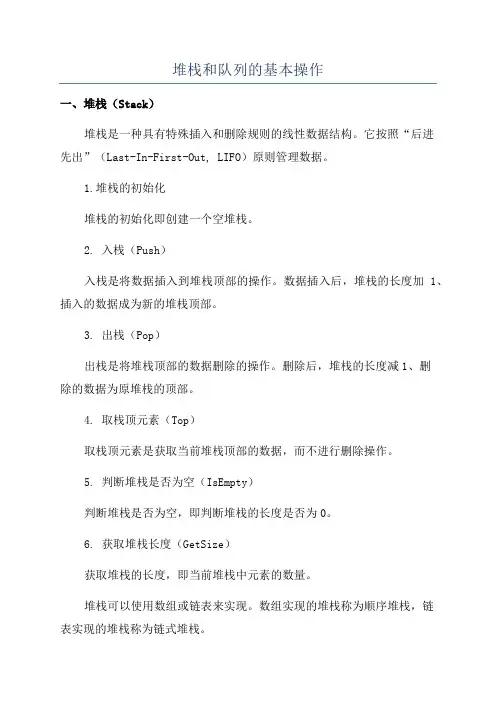
堆栈和队列的基本操作一、堆栈(Stack)堆栈是一种具有特殊插入和删除规则的线性数据结构。
它按照“后进先出”(Last-In-First-Out, LIFO)原则管理数据。
1.堆栈的初始化堆栈的初始化即创建一个空堆栈。
2. 入栈(Push)入栈是将数据插入到堆栈顶部的操作。
数据插入后,堆栈的长度加1、插入的数据成为新的堆栈顶部。
3. 出栈(Pop)出栈是将堆栈顶部的数据删除的操作。
删除后,堆栈的长度减1、删除的数据为原堆栈的顶部。
4. 取栈顶元素(Top)取栈顶元素是获取当前堆栈顶部的数据,而不进行删除操作。
5. 判断堆栈是否为空(IsEmpty)判断堆栈是否为空,即判断堆栈的长度是否为0。
6. 获取堆栈长度(GetSize)获取堆栈的长度,即当前堆栈中元素的数量。
堆栈可以使用数组或链表来实现。
数组实现的堆栈称为顺序堆栈,链表实现的堆栈称为链式堆栈。
堆栈的应用:-递归函数的调用和返回-表达式求值-括号匹配-浏览器前进后退功能二、队列(Queue)队列也是一种具有特定插入和删除规则的线性数据结构。
它按照“先进先出”(First-In-First-Out, FIFO)原则管理数据。
1.队列的初始化队列的初始化即创建一个空队列。
2. 入队(Enqueue)入队是将数据插入到队列尾部的操作。
数据插入后,队列的长度加1、插入的数据成为新的队列尾部。
3. 出队(Dequeue)出队是将队列头部的数据删除的操作。
删除后,队列的长度减1、删除的数据为原队列的头部。
4. 获取队首元素(Peek)获取队列头部的数据,而不进行删除操作。
5. 判断队列是否为空(IsEmpty)判断队列是否为空,即判断队列的长度是否为0。
6. 获取队列长度(GetSize)获取队列的长度,即当前队列中元素的数量。
队列也可以使用数组或链表来实现。
数组实现的队列称为顺序队列,链表实现的队列称为链式队列。
还有一种特殊的队列称为优先队列,它根据元素的优先级进行排序。
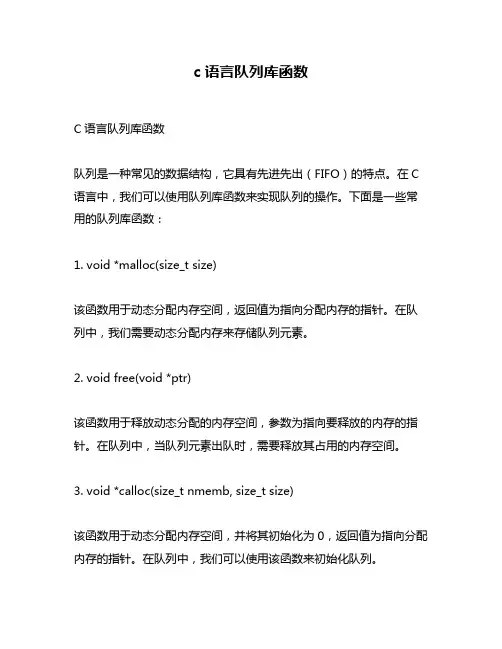
c语言队列库函数C语言队列库函数队列是一种常见的数据结构,它具有先进先出(FIFO)的特点。
在C 语言中,我们可以使用队列库函数来实现队列的操作。
下面是一些常用的队列库函数:1. void *malloc(size_t size)该函数用于动态分配内存空间,返回值为指向分配内存的指针。
在队列中,我们需要动态分配内存来存储队列元素。
2. void free(void *ptr)该函数用于释放动态分配的内存空间,参数为指向要释放的内存的指针。
在队列中,当队列元素出队时,需要释放其占用的内存空间。
3. void *calloc(size_t nmemb, size_t size)该函数用于动态分配内存空间,并将其初始化为0,返回值为指向分配内存的指针。
在队列中,我们可以使用该函数来初始化队列。
4. void *realloc(void *ptr, size_t size)该函数用于重新分配内存空间,参数为指向要重新分配的内存的指针和新的内存大小。
在队列中,当队列元素入队时,如果队列已满,需要重新分配内存空间。
5. int printf(const char *format, ...)该函数用于输出格式化的字符串,参数为格式化字符串和可变参数列表。
在队列中,我们可以使用该函数来输出队列元素。
6. int scanf(const char *format, ...)该函数用于输入格式化的数据,参数为格式化字符串和可变参数列表。
在队列中,我们可以使用该函数来输入队列元素。
7. void *memcpy(void *dest, const void *src, size_t n)该函数用于将源内存区域的内容复制到目标内存区域,参数为目标内存指针、源内存指针和要复制的字节数。
在队列中,我们可以使用该函数来复制队列元素。
8. void *memmove(void *dest, const void *src, size_t n)该函数用于将源内存区域的内容移动到目标内存区域,参数为目标内存指针、源内存指针和要移动的字节数。
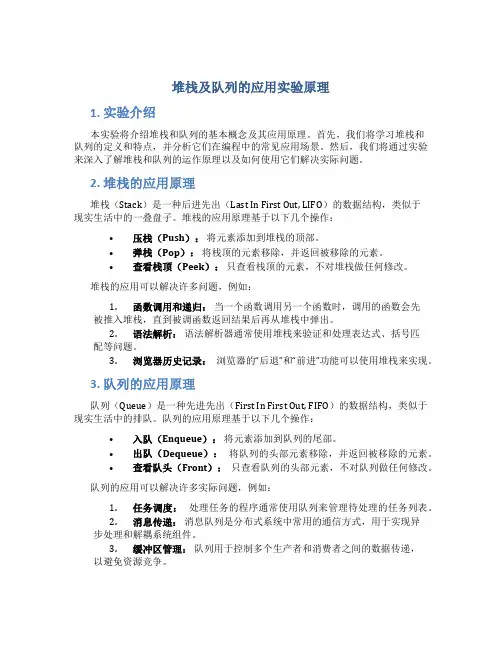
堆栈及队列的应用实验原理1. 实验介绍本实验将介绍堆栈和队列的基本概念及其应用原理。
首先,我们将学习堆栈和队列的定义和特点,并分析它们在编程中的常见应用场景。
然后,我们将通过实验来深入了解堆栈和队列的运作原理以及如何使用它们解决实际问题。
2. 堆栈的应用原理堆栈(Stack)是一种后进先出(Last In First Out, LIFO)的数据结构,类似于现实生活中的一叠盘子。
堆栈的应用原理基于以下几个操作:•压栈(Push):将元素添加到堆栈的顶部。
•弹栈(Pop):将栈顶的元素移除,并返回被移除的元素。
•查看栈顶(Peek):只查看栈顶的元素,不对堆栈做任何修改。
堆栈的应用可以解决许多问题,例如:1.函数调用和递归:当一个函数调用另一个函数时,调用的函数会先被推入堆栈,直到被调函数返回结果后再从堆栈中弹出。
2.语法解析:语法解析器通常使用堆栈来验证和处理表达式、括号匹配等问题。
3.浏览器历史记录:浏览器的“后退”和“前进”功能可以使用堆栈来实现。
3. 队列的应用原理队列(Queue)是一种先进先出(First In First Out, FIFO)的数据结构,类似于现实生活中的排队。
队列的应用原理基于以下几个操作:•入队(Enqueue):将元素添加到队列的尾部。
•出队(Dequeue):将队列的头部元素移除,并返回被移除的元素。
•查看队头(Front):只查看队列的头部元素,不对队列做任何修改。
队列的应用可以解决许多实际问题,例如:1.任务调度:处理任务的程序通常使用队列来管理待处理的任务列表。
2.消息传递:消息队列是分布式系统中常用的通信方式,用于实现异步处理和解耦系统组件。
3.缓冲区管理:队列用于控制多个生产者和消费者之间的数据传递,以避免资源竞争。
4. 实验步骤本实验将使用编程语言来模拟堆栈和队列的应用原理。
具体步骤如下:1.定义堆栈类和队列类:创建一个堆栈类和一个队列类,分别实现堆栈和队列的基本操作。
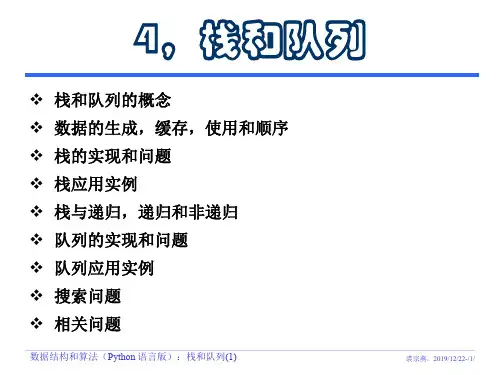
c++堆栈使用方法堆栈是计算机科学中的一个重要概念,也是C语言中常用的一种数据结构。
在堆栈中,数据按照后进先出(LIFO)的原则进行存储和操作,这在很多场合下都非常有用。
本文将介绍如何在C语言中使用堆栈,包括堆栈的基本概念、数据类型、创建、初始化、操作等。
一、堆栈的基本概念堆栈是一种特殊的线性表,它只允许在顶部进行数据添加和删除操作。
在堆栈顶部的数据被添加和删除的速度最快,因此堆栈也被称为“先进后出”(LIFO)的数据结构。
在C语言中,可以使用数组来实现堆栈。
二、C语言中的堆栈数据类型在C语言中,可以使用数组来定义一个堆栈。
通常,我们使用一个特殊的指针来表示堆栈的顶部,该指针指向当前堆栈的最后一个元素。
堆栈的大小可以通过数组的大小来确定,也可以根据需要进行动态调整。
三、创建和初始化堆栈在C语言中,可以使用malloc()函数来动态分配内存空间来创建一个堆栈对象。
在使用malloc()函数之前,需要先定义一个大小足够大的数组来存储堆栈数据。
以下是一个简单的示例代码,用于创建一个大小为10的堆栈对象并初始化:```c#include <stdio.h>#include <stdlib.h>#define MAX_STACK_SIZE 10int main() {int stack[MAX_STACK_SIZE];int top = -1; // 初始化时堆栈为空int *p = stack; // 指向堆栈顶部的指针// 初始化堆栈for (int i = 0; i < MAX_STACK_SIZE; i++) {stack[i] = i; // 将元素依次存入堆栈中}// 输出初始化后的堆栈内容printf("初始化后的堆栈内容:");for (int i = 0; i <= top; i++) {printf("%d ", stack[i]); // 从顶部开始输出元素}printf("\n");return 0;}```四、操作堆栈使用堆栈时,可以通过push()函数将元素添加到堆栈顶部,通过pop()函数从堆栈顶部删除元素,通过peek()函数查看堆栈顶部的元素但不删除它。
VBS脚本中的字典、动态数组、队列和堆栈实现代码1.编写环境今天突发奇想下载了个gVim来写VBS脚本,我⽤的版本是7.4的在写脚本前,需要在gVim的安装根⽬录下,找到⽂件“_vimrc”,在⾥⾯添加下⾯三⾏:set numberset softtabstop=4set tabstop=4意思分别是“显⽰⾏号”、“按退格键⼀次删掉4个空格”和“设定Tab长度为4个字符”这个设置类似于Linux系统下⽂件“.vimrc”的配置1.字典:Scripting.DictionaryVBS中的字典需要使⽤Scripting.Dictionary脚本⽂件:a.vbs,包含字典的添加、删除、判断键是否存在、修改键、修改值、遍历、统计键值对个数Option Explicit'建⽴字典Dim Dict : Set Dict = CreateObject("Scripting.Dictionary")'添加键值对Dict.Add "Key1", "Item1"Dict.Add "Key2", "Item2"Dict.Add "Key3", "Item3"'字典中键值对数量WScript.Echo "字典中现有键值对数量: " & Dict.CountWScript.Echo'检查指定键是否存在If Dict.Exists("Key1") ThenWScript.Echo "Key1 存在!"ElseWScript.Echo "Key1 不存在!"End IfIf Dict.Exists("Keyn") ThenWScript.Echo "Keyn 存在!"ElseWScript.Echo "Keyn 不存在!"End IfWScript.Echo'遍历字典Sub TraverseDictDim DictKeys, DictItems, CounterDictKeys = Dict.KeysDictItems = Dict.ItemsFor Counter = 0 To Dict.Count - 1WScript.Echo _"键: " & DictKeys(Counter) & _"值: " & DictItems(Counter)NextEnd SubTraverseDictWScript.Echo'在⼀个键值对中,修改键或修改值Dict.Key("Key2") = "Keyx"Dict.Item("Key1") = "Itemx"TraverseDictWScript.Echo'删除指定键Dict.Remove("Key3")TraverseDictWScript.Echo'删除全部键Dict.RemoveAllWScript.Echo "字典中现有键值对数量: " & Dict.Count调⽤⽅法:通过双击a.bat调⽤,a.bat代码如下:cscript a.vbspause运⾏结果截图:2.动态数组:System.Collections.ArrayListVBS中的动态数组需要使⽤System.Collections.ArrayList脚本⽂件:b.vbs,包含动态数组的添加元素、删除元素、遍历、统计元素个数、清空Option Explicit'建⽴动态数组Dim Arrl : Set Arrl = CreateObject("System.Collections.ArrayList")'添加元素Arrl.Add "Element3"Arrl.Add "Element2"Arrl.Add "Element1"'查看动态数组中的元素数WScript.Echo "动态数组中现有元素数量: " & Arrl.CountWScript.Echo "动态数组容量: " & Arrl.CapacityWScript.Echo'遍历动态数组Sub TraverseArrlDim CounterFor Counter = 0 To Arrl.Count - 1WScript.Echo Arrl(Counter)NextEnd SubTraverseArrlWScript.Echo'动态数组排序Arrl.SortTraverseArrlWScript.Echo'删除指定元素Arrl.Remove("Element1")TraverseArrlWScript.Echo'清空全部元素Arrl.ClearWScript.Echo "动态数组中现有元素数量: " & Arrl.CountWScript.Echo "动态数组容量: " & Arrl.Capacity调⽤⽅法:通过双击b.bat调⽤,b.bat代码如下:cscript b.vbspause运⾏结果截图:3.队列:System.Collections.QueueVBS中的队列需要使⽤System.Collections.Queue脚本⽂件:c.vbs,包含队列的添加元素(⼊队)、删除元素(出队)、遍历、统计元素个数、清空Option Explicit'建⽴队列Dim Que : Set Que = CreateObject("System.Collections.Queue")Que.EnQueue("Element1")Que.EnQueue("Element2")Que.EnQueue("Element3")'查看队列中的元素数WScript.Echo "队列中的元素数: " & Que.CountWScript.Echo'遍历队列Sub TraverseQueDim ArrQue : ArrQue = Que.ToArrayDim CounterFor Counter = 0 To UBound(ArrQue)WScript.Echo ArrQue(Counter)NextEnd SubTraverseQueWScript.Echo'退出队列WScript.Echo Que.DeQueueWScript.Echo "---"TraverseQueWScript.Echo'清空队列Que.ClearWScript.Echo "队列中的元素数: " & Que.Count调⽤⽅法:通过双击c.bat调⽤,c.bat代码如下:cscript c.vbspause运⾏结果截图:4.堆栈:System.Collections.StackVBS中的堆栈需要使⽤System.Collections.Stack脚本⽂件:d.vbs,包含堆栈的添加元素(压栈)、删除元素(出栈)、遍历、统计元素个数、清空Option Explicit'建⽴堆栈Dim Stk : Set Stk = CreateObject("System.Collections.Stack")Stk.Push "Element1"Stk.Push "Element2"Stk.Push "Element3"'查看堆栈中的元素数WScript.Echo "堆栈中的元素数: " & Stk.CountWScript.Echo'遍历堆栈Sub TraverseStkDim ArrStk : ArrStk = Stk.ToArrayDim CounterFor Counter = 0 To UBound(ArrStk)WScript.Echo ArrStk(Counter)NextEnd SubTraverseStkWScript.Echo'元素出栈WScript.Echo Stk.PopWScript.Echo "---"TraverseStkWScript.Echo'清空堆栈Stk.ClearWScript.Echo "堆栈中的元素数: " & Stk.Count调⽤⽅法:通过双击d.bat调⽤,d.bat代码如下:cscript d.vbspause运⾏结果截图:可以看出,遍历队列和堆栈时,遍历顺序时由出队和出栈的顺序决定的,⽽不是⼊队和压栈的顺序。
c语言实现栈详细代码栈(Stack),又称堆栈,是一种后进先出(LIFO,Last In First Out)的数据结构,它只允许在一段端点进行插入和删除操作,这个端点被称为栈顶。
C语言实现栈的基本思路是建立一个结构体,结构体中包含一个数组和栈顶指针top。
数组用来存放栈中元素,top指针指向栈顶元素的下标。
实现栈的操作包括压栈(push)、出栈(pop)和获取栈顶元素(get_top)。
下面是详细代码:```#include <stdio.h>#include <stdlib.h>#define MAX_SIZE 100 //栈的最大长度typedef struct stack {int data[MAX_SIZE]; //栈中元素int top; //栈顶指针} Stack;//初始化栈void init(Stack *s) {s->top = -1; //栈顶指针初始化为-1,表示栈为空}//判断栈是否为空int is_empty(Stack *s) {return s->top == -1;}//判断栈是否已满int is_full(Stack *s) {return s->top == MAX_SIZE-1;}//压栈void push(Stack *s, int value) {if (is_full(s)) {printf("Stack is full, cannot push!\n");return;}s->data[++(s->top)] = value; //栈顶指针先加1,再将元素入栈}//出栈void pop(Stack *s) {if (is_empty(s)) {printf("Stack is empty, cannot pop!\n");}s->top--; //栈顶指针减1,表示栈顶元素已删除}//获取栈顶元素int get_top(Stack *s) {if (is_empty(s)) {printf("Stack is empty, cannot get top element!\n"); return -1;}return s->data[s->top]; //返回栈顶元素}int main() {Stack s;init(&s); //初始化栈for (i = 0; i < 5; i++) {push(&s, i); //压入5个元素}printf("Top element: %d\n", get_top(&s)); //获取栈顶元素while (!is_empty(&s)) {printf("%d ", get_top(&s)); //依次输出栈中元素pop(&s); //弹出栈顶元素}return 0;}```代码中定义了一个结构体,包含一个整型数组data和一个整型变量top,数组用来存放栈中元素,top表示栈顶指针。
建立堆栈和队列的库函数
摘要
堆栈是一种只允许在表的一端进行插入和删除运算的特殊的线性表。
链式存储结构:栈的链式存储结构称为链栈,通常用单链表示。
链栈的插入和删除操作只需处理栈顶的情况。
每次进栈的数据元素都放在原当前栈顶元素之前成为新的栈顶元素,每次退栈的数据元素都是原当前栈顶元素,最后进入堆栈的数据元素总是最先退出堆栈。
队列是允许在表的一端进行插入,而在表的另一端进行删除的特殊线性表。
允许进行插入的一端称为队尾,允许进行删除的一端称为队头。
用链式存储结构存储的队列称为链队列。
链队列的基本操作的实现基本上也是单链表操作的简化。
通常附设头结点,并设置队头指针指向头结点,队尾指针指向终端结点。
插入数据时只考虑在链队列的尾部进行,删除数据时只考虑在链队列的头部进行。
关键词:堆栈;队列;线性表;存储结构
第1章前言
栈和队列是两种常用的数据结构,广泛应用在编译软件和程序设计,操作系统、事物管理等各类软件系统中。
从数据结构角度看,栈和队列是受限制的线性表,栈和队列的数据元素具有单一的前驱和后继的线性关系;从抽象数据类型角度看,栈和队列又是两种重要的抽象数据类型。
第2章堆栈和队列定义
2.1 定义
栈作为一种数据结构,是一种只能在一端进行插入和删除操作的特殊线性表。
它按照后进先出的原则存储数据,先进入的数据被压入栈底,最后的数据在栈顶,需要读数据的时候从栈顶开始弹出数据(最后一个数据被第一个读出来)。
栈具有记忆作用,对栈的插入与删除操作中,不需要改变栈底指针。
栈是允许在同一端进行插入和删除操作的特殊线性表。
允许进行插入和删除操作的一端称为栈顶(top),另一端为栈底(bottom);栈底固定,而栈顶浮动;栈中元素个数为零时称为空栈。
插入一般称为进栈(PUSH),删除则称为退栈(POP)。
栈也称为后进先出表。
队列是一种特殊的线性表,它只允许在表的前端(front)进行删除操作,而在表的后端(rear)进行插入操作。
进行插入操作的端称为队尾,进行删除操作的端称为队头。
队列中没有元素时,称为空队列。
在队列这种数据结构中,最先插入的元素将是最先被删除的元素;反之最后插入的元素将是最后被删除的元素,因此队列又称为“先进先出”的线性表。
2.2 队列基本操作
2.2.1栈的建立和初始化:
voidInitStack(SqStack * &s)
{
s=(SqStack * )malloc(sizeof(SqStack)); s->top=-1;
}
2.2.2入栈函数及操作:
bool Push(SqStack * &s,int e)
{
if(s->top==MaxSize-1)
return false;
s->top++;
s->data[s->top]=e;
return true;
}
2.2.3出栈函数及操作:
bool Push(SqStack * &s,int e)
{
if(s->top==MaxSize-1)
return false;
s->top++;
s->data[s->top]=e;
return true;
}
2.2.4取栈顶元素操作:boolGetTop(SqStack * &s,int&e)
{
if(s->top==-1)
return false;
e=s->data[s->top];
return true;
}
第3章堆栈和队列的实现方法
栈的链接存储结构与线性表的链接存储结构相同,是通过由结点构成的单链表实现的,此时表头指针称为栈顶指针,由栈顶指针指向的表头结点称为栈顶结点,整个单链表称为链栈,即链接存储的栈。
当向一个链栈插入元素时,是把该元素插入到栈顶,即使该元素结点的指针域指向原来的栈顶结点,而栈顶指针则修改为指向该元素结点,使该结点成为新的栈顶结点。
当从一个链栈中删除元素时,是把栈顶元素结点删除掉,即取出栈顶元素后,使栈顶指针指向原栈顶结点的后继结点。
由此可知,对链栈的插入和删除操作是在单链表的表头进行的,其时间复杂度为O(1)。
在队列的形成过程中,可以利用线性链表的原理,来生成一个队列。
基于链表的队列,要动态创建和删除节点,效率较低,但是可以动态增长。
队列采用的“先进先出”,新元素(等待进入队列的元素)总是被插入到链表的尾部,而读取的时候总是从链表的头部开始读取。
每次读取一个元素,释放一个元素。
所谓的动态创建,动态释放。
因而也不存在溢出等问题。
由于链表由结构体间接而成,遍历也方便。
3.1堆栈的流程图
3.2分析功能
堆栈:
(1)初始化链栈(2)链栈置空(3)入栈
(4)出栈
(5)遍历链栈
3.3堆栈的源代码
#include<stdio.h>
#include<stdlib.h>
#define MaxSize 10000 typedefstruct
{
int data[MaxSize];
int top;
}SqStack;
voidInitStack(SqStack * &s)
{
s=(SqStack * )malloc(sizeof(SqStack)); s->top=-1;
}
boolStackEmpty(SqStack *s)
{
return(s->top==-1);
}
bool Push(SqStack * &s,int e)
{
if(s->top==MaxSize-1)
return false;
s->top++;
s->data[s->top]=e;
return true;
}
bool Pop(SqStack * &s,int&e)
{
if(s->top==-1)
return false;
e=s->data[s->top];
s->top--;
return true;
}
boolGetTop(SqStack * &s,int&e)
{
if(s->top==-1)
return false;
e=s->data[s->top];
return true;
}
int main()
{
intn,i,inys,ding,outys;
SqStack *l;
InitStack(l);
printf("输入进栈元素个数:");
scanf("%d",&n);
for(i=0;i<n;i++)
{ printf("输入第%d个进栈元素:",i+1);
scanf("%d",&inys);
Push(l,inys);
}
GetTop(l,ding);
printf("栈顶元素为:%d\n",ding);
for(i=0;i<n;i++)
{
Pop(l,outys);
printf("%d \n",outys);
if(StackEmpty(l))
{
printf(" 为空栈\n");
}
else
{
printf("不为空栈\n");
}
}
return 0;
}
3.4测试与运行
结语
栈和队列是两种常用的数据结构,广泛应用在编译软件和程序设计,操作系统、事物管理等各类软件系统中。
从数据结构角度看,栈和队列是受限制的线性表,栈和队列的数据元素具有单一的前驱和后继的线性关系;从抽象数据类型角度看,栈和队列又是两种重要的抽象数据类型。
通过本次的数据结构实验,我掌握了堆栈和队列的基本操作以及实现他们的算法,对他们有了一个更加具体、深刻的认识,帮助以后解决实际问题。
掌握了这一系列的方法,会为我们今后的继续学习带来很大的帮助。
参考文献
[1]《数据结构(C语言版)》严蔚敏吴伟民编著清华大学出版社。